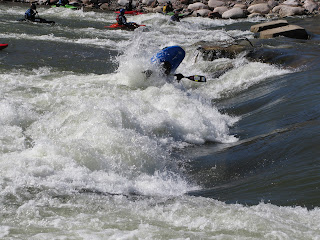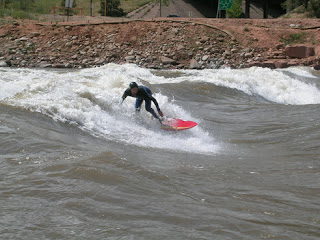In the late 1990’s and early 2000’s the era of the whitewater park began. While freestyle kayaking, what we often call “playboating”, had been popular in various forms for several decades, rapidly shortening boats shrank the river features kayakers were able to play in. The appeal of “park and play” was obvious. No need for a shuttle; no need for the hassle. You could boat at your own pace for as long or short and hard or casual as desired. A few pioneering towns had the notion of creating artificial play park-and-play waves to boost local economy. Salida and Buena Vista on the Arkansas River were among the first. Utilizing the already existing platform of FibArk—a whitewater competition which at the time was primarily focused on the downriver and, to a lesser extent, slalom races—the boaters of the Arkansas Valley created what is to this day one of the best and most prestigious freestyle kayaking events in the world held at the artificial wave in Salida.
 |
| The Park at low water |
In the middle of the first decade of the 2000’s, new energy reinvigorated the movement of the Glenwood Springs Whitewater Park, which had previously been stalled by concerns of the Hot Springs Lodge and Pool that any dredging on the basement rock during the park’s construction could adversely affect the hot springs aquifer and threaten their multi-million dollar property. An ad-hoc committee was officially appointed by the city and charged with seeing the project through to its conclusion. I was lucky enough to take part in the process during those final crucial years.
The committee consisted of about a dozen core members, consisting of local business owners, a smattering of kayakers of various ilk, and other non-boating members of the local population who, for whatever reason, took a shine to the dream of a whitewater park. Local engineer/hydrologist Jason Carey was brought in to the discussions. It was Jason and his partner Nick Turner who would ultimately do much of surveying for and designing of the whitewater park as it exists today.
Since Two Rivers Park was deemed too close to the hot springs aquifer, a number of alternatives were considered, including Glenwood Canyon, South Canyon, numerous spots along the Roaring Fork River, and on the Colorado in West Glenwood just upstream or just downstream of the Midland Avenue Bridge. There were several key components that the committee was looking for in the site, and it seemed that none of the options had them all. The location had to have gradient, be accessible, have parking, be publicly owned, and have potential to draw visitors into Glenwood Springs to spend their money (otherwise what interest did the city or county have in paying for the park in the first place).
 |
| The Park at 4,000 cfs |
We eliminated South Canyon next. Though there was great potential since the city owned the land and parking was plentiful, the committee decided that South Canyon was simply too far from town and would not draw in visitors to Glenwood Springs the way it potentially could.
Glenwood Canyon also had several strong possible locations and seemed more closely connected to town than South Canyon. However, access in the tight corridors of Glenwood Canyon ultimately made the logistics impossible. We turned our eyes to the only possibility that was left: West Glenwood.
We scouted the West Glenwood location extensively in 2006 and 2007; originally thinking that downstream of the Midland Avenue Bridge was the most likely spot. Most of the hotels and restaurants in the vicinity were cooperative and enthusiastic about the project. Feeling we had found our location at last, we began the process of obtaining permits and seeking funding.
The many months that followed were spent applying for grants and prodding city council and the Board of County Commissioners for money. After several failed attempts at a GoCo (Great Outdoors Colorado) grant, the City of Glenwood Springs, with some help from Garfield County, decided to invest whatever it would take to finish the complete the project. Now we had our location and our money and all that remained was to get our rocks down in that river.
Construction began at last in the winter of 2007/2008, one of the heaviest snow years in a decade. Eco-friendly oils and fuels were required for all machinery that entered the river. The feature was built in two halves and un-veiled in the early spring of 2008. When the resulting runoff from the heavy snow came, we watched in wonder as the feature we had conceived ran the spectrum of possible flows. While the original intention had been to build a wave that was good mostly at the target levels of 4,000 cfs and below, we discovered that the feature not only still worked above 4,000 cfs but that as the water came up the wave seemed to only get better. Many Roaring Fork Valley playboater burned hours upon hours that first year on the wave, excited with each new day to see how the feature changed. The river reached 8,000 and it turned from a hole to wave. At 10,000 it was a spinning, front surfing, roundhouse machine. By 12,000 the good boaters were getting full-on aerial tricks. Buzz circulated the freestyle scene and playboaters from all over came to see what it was all about. Some of the best playboaters in the world camped out in Glenwood for several long weeks.
 |
| Surfing the Park at 15,000 cfs |
The river peaked that first season just over 20,000 cfs, toppling a few of the newly constructed boulders in the process. Corrections were made and the banks improved in subsequent years.
In the spring of 2009 the hype surrounding the park allowed Glenwood to win the bid for U.S. Team Trials for the 2010 World Cup team. The event was held at the new whitewater park in late May of 2009 at flows around 15,000 cfs. The town of Glenwood Springs later declined an invite to host the World Championships, citing a lack of necessary infrastructure to accommodate such an event at the site.
The runoffs of 2010 and 2011 were epic, boasting some of the highest and most sustained flows the valley had seen since the infamous record years of 1983 and 1984. 2011 was especially memorable. Late spring snows and cool temperatures kept the water high. The river peaked in late June at over 27,000 cfs through the park and stayed well over 15,000 cfs for almost three months. No matter how high the flows got, the wave only seemed to get better. As far as we have discovered, there is absolutely no level in which there isn’t some play at the Glenwood Whitewater Park.

No comments:
Post a Comment